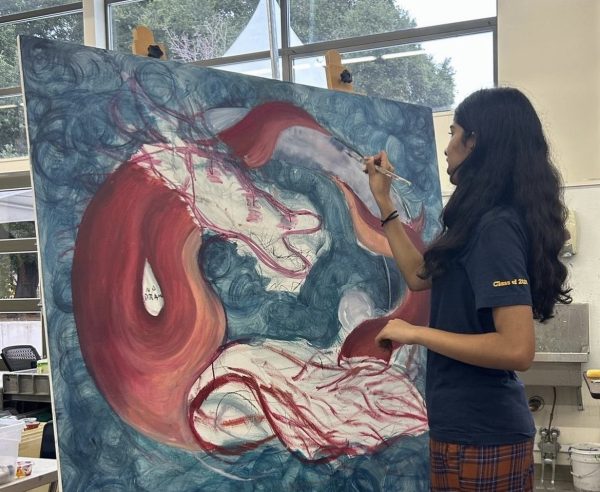Puppy Popularity Rises During Coronavirus Pandemic
Freshman Brooke Dombkwoski’s eight-week-old golden retriever puppy, Tucker. Photo courtesy Brooke Dombkowski.
May 14, 2020
Amid the negative spell cast by the COVID-19 pandemic, one unexpected positive outcome has emerged: a rise in puppy popularity.
According to a CNN article, the rise in dog owners and fosterers is unprecedented. This increase is evident with Foster Dogs Inc, where they saw more than a 1,000% increase in foster applications during March. This pattern is also apparent among Menlo School’s student body and faculty.
Freshman Brooke Dombkowski and her family had always wanted a dog but did not have the time to take care of one. However, shelter-in-place orders have increased the amount of time families spend at home, and Dombkowski’s mother seized this opportunity to surprise her family with Tucker – a four-week-old golden retriever.
So far, living with Tucker has been manageable for the Dombkowskis, and the extra time at home has been helpful in raising a new puppy. “We’ve been able to train and spend more time with him, […] which has helped with bonding,” Dombkowski said.
COVID-19 has impacted mental health conditions for the worse, as there has been a 19% increase in clinical anxiety, according to Mental Health America. This negative impact of COVID-19 may have contributed to the increase in puppy ownership because dogs can help combat anxiety-induced thoughts, according to an article from the UK-based Mental Health Foundation.
Throughout Dombkowski’s quarantine thus far, Tucker has exemplified that puppies can help reduce anxiety, as he has improved her family’s overall happiness and well-being. “Puppies are great because […] they provide a boost of happiness in [someone’s] day and can improve mental health,” Dombkowski said.
Likewise, Menlo’s Health Services Coordinator and Administrator of the Child Care Center Joan Barada is going to live with a puppy throughout quarantine. She plans to pick up her eight-week-old golden retriever, Margot, at the beginning of May. For Barada, however, living with a dog is not unfamiliar territory. Barada’s past dogs include a golden retriever, a labrador retriever and not to mention, her current dog, a chihuahua-golden retriever mix.
“Dogs are beneficial psychologically […] because they can help calm people,” Barada said. As previous dog owner, she has reaped the benefits of owning and raising dogs in the past and hopes to continue to do so with Margot. “They are something that you can cuddle with and feel connected to,” she said.
For freshman Malia Chavinson, a new puppy has helped occupy her family’s time in quarantine as well. “Milo, a cross between a Bernese mountain dog and a poodle, has needed a lot of attention, and it’s great because we have the time to do that,” Chavinson said. “But that also means that because we have the time to do it, so much of our life revolves around him.”
Taking care of Milo throughout COVID-19 has had its advantages, but there have also been some downsides. “There have been times where we have to interrupt our classes to take him out,” Chavinson said. Nonetheless, “Taking care of him has given us a little bit of purpose in this time where we’re so uncertain of what’s happening.”
English teacher Oscar King has been living with Renaissance, his new dachshund puppy, for the past six weeks. “Dogs offer a distraction and are something to occupy your time that isn’t screen-related,” King said. “They establish a schedule and help [to] create normalcy.”
Moreover, although senior Kendall Weingart planned on getting a dog prior to the COVID-19 pandemic, she has lived with three-month-old Willie, a Tibetan terrier, throughout quarantine. “[He’s] been a ray of sunshine and something to look forward to after doing schoolwork throughout the day,” Weingart said.
While the quarantine has temporarily offered more time for new pet additions, what happens when people have to return to their normal lifestyles?
“I think getting a puppy [in quarantine] is a good idea as long as you have wanted a dog for a while and think you’ll be able to support it after [quarantine is over],” Weingart said.
Prior to COVID-19, Barada’s typical day revolved around her work at Menlo, a campus where dogs aren’t permitted. This lifestyle has previously prevented Barada from considering a new puppy, but her current shelter-in-place routine can now accommodate a new addition to the house.
“I’m worried about the dog being unhappy [after quarantine] when it is alone and I’m at work,” Barada said.
Nonetheless, as of right now, it is evident that puppies have helped add color to life at home throughout the COVID-19 pandemic so far. “Puppies are just bundles of joy. [Willie] has really helped in adding light to my day,” Weingart said.













